Variation in Soil Aggregate Stability Due to Land Use Changes from Alpine Grassland in a High-Altitude Watershed
Abstract
:1. Introduction
2. Materials and Methods
2.1. Study Area
2.2. Experimental Design and Field Sampling
2.3. Data Analysis
2.4. Statistical Analysis
3. Results
3.1. Soil Characteristics
3.2. Variation Characteristics of Soil Aggregates
3.3. Correlations of Aggregate Stability with SOC and Soil Particle Composition
4. Discussion
4.1. Effects of Land Use Type, Soil Depth and How They Interact on Soil Properties
4.2. Distributions of Soil Aggregate Stability
4.3. Correlations of Aggregate Stability with SOC and Soil Particle Composition
5. Conclusions
- (1)
- Following cropland abandonment, macro-aggregate distribution and aggregate stability increased, while micro-aggregate and silt+clay decreased significantly. This indicates that tillage will destroy the macro-aggregates in the soil, resulting in decreased aggregate stability; abandoning cropland reduced the destruction of aggregates and improve aggregate stability, but there was still a certain disparity compared with natural grassland.
- (2)
- During the conversion of alpine grassland to cropland and abandoned land, SOC and soil particle composition had significant effects on soil aggregate stability. Among them, SOC content, silt content and clay content were positively correlated with aggregate stability, while sand content was negatively correlated with soil aggregate stability. Clay and silt promoted the formation of macro-aggregates and enhanced aggregate stability, while sand was not conducive to the formation of macro-aggregates and aggregate stability. Additionally, in this study, sand was more likely to affect soil aggregates and their stability.
- (3)
- Compared with temperate grassland, alpine grassland had higher SOC content, soil aggregate stability and distribution of macro-aggregates. Low soil temperature in alpine grasslands inhibits microbial activity, which can effectively prevent the loss of organic carbon. In addition, the alpine grassland accumulated huge root biomass, providing a rich source of organic matter for the soil. However, this result is not absolute, depending on the specific sampling environment. Microclimates may produce different results.
Author Contributions
Funding
Institutional Review Board Statement
Informed Consent Statement
Data Availability Statement
Acknowledgments
Conflicts of Interest
References
- Oades, J.M.; Waters, A.G. Aggregate hierarchy in soils. Soil Res. 1991, 29, 815–828. [Google Scholar] [CrossRef]
- Six, J.; Bossuyt, H.; Degryze, S.; Denef, K. A history of research on the link between (micro)aggregates, soil biota, and soil organic matter dynamics. Soil Tillage Res. 2004, 79, 7–31. [Google Scholar] [CrossRef]
- Cheng, M.; Xiang, Y.; Xue, Z.; An, S.; Darboux, F. Soil aggregation and intra-aggregate carbon fractions in relation to vegetation succession on the Loess Plateau, China. Catena 2015, 124, 77–84. [Google Scholar] [CrossRef]
- Elhaja, M.; Ibrahim, I.; Adam, H.; Csaplovics, E. Soil aggregate stability and wind erodible fraction in a semi-arid environment of White Nile State, Sudan. In Proceedings of SPIE—The International Society for Optical Engineering; SPIE: Bellingham, WA, USA, 2014; Volume 9260. [Google Scholar] [CrossRef]
- Gallardo-Carrera, A.; Léonard, J.; Duval, Y.; Dürr, C. Effects of seedbed structure and water content at sowing on the development of soil surface crusting under rainfall. Soil Tillage Res. 2007, 95, 207–217. [Google Scholar] [CrossRef]
- Rabot, E.; Wiesmeier, M.; Schlüter, S.; Vogel, H.J. Soil structure as an indicator of soil functions: A review. Geoderma 2018, 314, 122–137. [Google Scholar] [CrossRef]
- Caplan, J.; Giménez, D.; Subroy, V.; Heck, R.; Prior, S.; Runion, G.B.; Torbert, H. Nitrogen-mediated effects of elevated CO2 on intra-aggregate soil pore structure. Glob. Chang. Biol. 2016, 23, 1585–1597. [Google Scholar] [CrossRef]
- Dong, S.; Zhang, J.; Li, Y.; Liu, S.; Dong, Q.; Zhou, H.; Yeomans, J.; Li, Y.; Li, S.; Gao, X. Effect of grassland degradation on aggregate-associated soil organic carbon of alpine grassland ecosystems in the Qinghai-Tibetan Plateau. Eur. J. Soil Sci. 2020, 71, 69–79. [Google Scholar] [CrossRef]
- Dou, Y.; Yang, Y.; An, S.; Zhu, Z. Effects of different vegetation restoration measures on soil aggregate stability and erodibility on the Loess Plateau, China. Catena 2020, 185, 104294. [Google Scholar] [CrossRef]
- Idowu, O. Relationships Between Aggregate Stability and Selected Soil Properties in Humid Tropical Environment. Commun. Soil Sci. Plant Anal. 2003, 34, 695–708. [Google Scholar] [CrossRef]
- Poirier, V.; Roumet, C.; Munson, A.D. The root of the matter: Linking root traits and soil organic matter stabilization processes. Soil Biol. Biochem. 2018, 120, 246–259. [Google Scholar] [CrossRef]
- Caravaca, F.; Lax, A.; Albaladejo, J. Soil aggregate stability and organic matter in clay and fine silt fractions in urban refuse-amended semiarid soils. Soil Sci. Soc. Am. J. 2001, 65, 1235–1238. [Google Scholar] [CrossRef]
- Razafimbelo, T.M.; Albrecht, A.; Oliver, R.; Chevallier, T.; Chapuis-Lardy, L.; Feller, C. Aggregate associated-C and physical protection in a tropical clayey soil under Malagasy conventional and no-tillage systems. Soil Tillage Res. 2008, 98, 140–149. [Google Scholar] [CrossRef]
- Dorji, T.; Field, D.J.; Odeh, I.O.A.; Bhogal, A. Soil aggregate stability and aggregate-associated organic carbon under different land use or land cover types. Soil Use Manag. 2020, 36, 308–319. [Google Scholar] [CrossRef]
- Deng, L.; Kim, D.G.; Peng, C.; Shangguan, Z. Controls of soil and aggregate-associated organic carbon variations following natural vegetation restoration on the Loess Plateau in China. Land Degrad. Dev. 2018, 29, 3974–3984. [Google Scholar] [CrossRef]
- Zhu, G.-y.; Shangguan, Z.-p.; Deng, L. Variations in soil aggregate stability due to land use changes from agricultural land on the Loess Plateau, China. Catena 2021, 200, 105181. [Google Scholar] [CrossRef]
- Li, X.G.; Zhang, P.L.; Yin, P.; Li, Y.K.; Ma, Q.F.; Long, R.J.; Li, F.M. Soil organic carbon and nitrogen fractions and water-stable aggregation as affected by cropping and grassland reclamation in an arid sub-alpine soil. Land Degrad. Dev. 2009, 20, 176–186. [Google Scholar] [CrossRef]
- Pan, J.; Wang, J.; Zhang, R.; Tian, D.; Cheng, X.; Wang, S.; Chen, C.; Yang, L.; Niu, S. Microaggregates regulated by edaphic properties determine the soil carbon stock in Tibetan alpine grasslands. CATENA 2021, 206, 105570. [Google Scholar] [CrossRef]
- Sherman, R. Enhancing the resilience of coupled human and natural systems of alpine rangelands on the Qinghai-Tibetan Plateau. Rangel. J. 2015, 37. [Google Scholar] [CrossRef]
- Leifeld, J.; Zimmermann, M.; Fuhrer, J.; Conen, F. Storage and turnover of carbon in grassland soils along an elevation gradient in the Swiss Alps. Glob. Chang. Biol. 2009, 15, 668–679. [Google Scholar] [CrossRef]
- Xu, M.; Li, X.; Cai, X.; Gai, J.; Li, X.; Christie, P.; Zhang, J. Soil microbial community structure and activity along a montane elevational gradient on the Tibetan Plateau. Eur. J. Soil Biol. 2014, 64, 6–14. [Google Scholar] [CrossRef]
- Le Bissonnais, Y.; Prieto, I.; Roumet, C.; Nespoulous, J.; Metayer, J.; Huon, S.; Villatoro, M.; Stokes, A. Soil aggregate stability in Mediterranean and tropical agro-ecosystems: Effect of plant roots and soil characteristics. Plant Soil 2017, 424, 303–317. [Google Scholar] [CrossRef]
- Smith, J.L.; Halvorson, J.J.; Bolton, H. Soil properties and microbial activity across a 500m elevation gradient in a semi-arid environment. Soil Biol. Biochem. 2002, 34, 1749–1757. [Google Scholar] [CrossRef]
- Wang, Y.; Ran, L.; Fang, N.; Shi, Z. Aggregate stability and associated organic carbon and nitrogen as affected by soil erosion and vegetation rehabilitation on the Loess Plateau. CATENA 2018, 167, 257–265. [Google Scholar] [CrossRef]
- Xiao, L.; Yao, K.; Li, P.; Liu, Y.; Chang, E.; Zhang, Y.; Zhu, T. Increased soil aggregate stability is strongly correlated with root and soil properties along a gradient of secondary succession on the Loess Plateau. Ecol. Eng. 2020, 143, 105671. [Google Scholar] [CrossRef]
- Zhu, G.-y.; Shangguan, Z.-p.; Deng, L. Soil aggregate stability and aggregate-associated carbon and nitrogen in natural restoration grassland and Chinese red pine plantation on the Loess Plateau. Catena 2017, 149, 253–260. [Google Scholar] [CrossRef]
- Zhang, L.; Tan, X.; Chen, H.; Liu, Y.; Cui, Z. Effects of Agriculture and Animal Husbandry on Heavy Metal Contamination in the Aquatic Environment and Human Health in Huangshui River Basin. Water 2022, 14, 549. [Google Scholar] [CrossRef]
- Chen, Q.; Yang, L.; Luo, J.; Liu, F.; Zhang, Y.; Zhou, Q.; Guo, R.; Gu, X. The 300-year cropland changes reflecting climate impacts and social resilience at the Yellow River-Huangshui River Valley, China. Environ. Res. Lett. 2021, 16, 065006. [Google Scholar] [CrossRef]
- Paudel, B.; Wu, X.; Zhang, Y.; Rai, R.; Liu, L.; Zhang, B.; Khanal, N.R.; Koirala, H.L.; Nepal, P. Farmland abandonment and its determinants in the different ecological villages of the Koshi river basin, central Himalayas: Synergy of high-resolution remote sensing and social surveys. Environ. Res. 2020, 188, 109711. [Google Scholar] [CrossRef]
- Wei, X.; Shao, M.; Gale, W.J.; Zhang, X.; Li, L. Dynamics of aggregate-associated organic carbon following conversion of forest to cropland. Soil Biol. Biochem. 2013, 57, 876–883. [Google Scholar] [CrossRef]
- Nelson, D.W.; Sommers, L.E. Total Carbon, Organic Carbon, and Organic Matter. In Methods of Soil Analysis; Wiley: Hoboken, NJ, USA, 1983; pp. 539–579. [Google Scholar]
- Sumner, M.E.; Miller, W.P. Cation Exchange Capacity and Exchange Coefficients. In Methods of Soil Analysis; Wiley: Hoboken, NJ, USA, 1996; pp. 1201–1229. [Google Scholar]
- Zhang, J.; Zhao, H.; Zhang, T.; Zhao, X.; Drake, S. Community succession along a chronosequence of vegetation restoration on sand dunes in Horqin Sandy Land. J. Arid. Environ. 2005, 62, 555–566. [Google Scholar] [CrossRef]
- An, S.-S.; Darboux, F.; Cheng, M. Revegetation as an efficient means of increasing soil aggregate stability on the Loess Plateau (China). Geoderma 2013, 209, 75–85. [Google Scholar] [CrossRef]
- Liu, M.; Han, G.; Li, Z.; Zhang, Q.; Song, Z. Soil organic carbon sequestration in soil aggregates in the karst Critical Zone Observatory, Southwest China. Plant Soil Environ. 2019, 65, 253–259. [Google Scholar] [CrossRef]
- Alías, J.C.; Mejías, J.A.; Chaves, N. Effect of Cropland Abandonment on Soil Carbon Stock in an Agroforestry System in Southwestern Spain. Land 2022, 11, 425. [Google Scholar] [CrossRef]
- Man, L.; Han, G.; Zhang, Q. Effects of Soil Aggregate Stability on Soil Organic Carbon and Nitrogen under Land Use Change in an Erodible Region in Southwest China. Int. J. Environ. Res. Public Health 2019, 16, 3809. [Google Scholar] [CrossRef]
- Zhang, C.; Liu, G.; Xue, S.; Sun, C. Soil organic carbon and total nitrogen storage as affected by land use in a small watershed of the Loess Plateau, China. Eur. J. Soil Biol. 2013, 54, 16–24. [Google Scholar] [CrossRef]
- Chen, Y.-L.; Ding, J.-Z.; Peng, Y.-F.; Li, F.; Yang, G.-B.; Liu, L.; Qin, S.-Q.; Fang, K.; Yang, Y.-H. Patterns and drivers of soil microbial communities in Tibetan alpine and global terrestrial ecosystems. J. Biogeogr. 2016, 43, 2027–2039. [Google Scholar] [CrossRef]
- Li, X.; Zhang, X.; Wu, J.; Shen, Z.; Zhang, Y.; Xu, X.; Fan, Y.; Zhao, Y.; Yan, W. Root biomass distribution in alpine ecosystems of the northern Tibetan Plateau. Environ. Earth Sci. 2011, 64, 1911–1919. [Google Scholar] [CrossRef]
- Baranian Kabir, E.; Bashari, H.; Mosaddeghi, M.R.; Bassiri, M. Soil aggregate stability and organic matter as affected by land use change in central Iran. Arch. Agron. Soil Sci. 2017, 63, 1823–1837. [Google Scholar] [CrossRef]
- Ayoubi, S.; Mokhtari Karchegani, P.; Mosaddeghi, M.R.; Honarjoo, N. Soil aggregation and organic carbon as affected by topography and land use change in western Iran. Soil Tillage Res. 2012, 121, 18–26. [Google Scholar] [CrossRef]
- Luo, Y.; Zhu, Z.; Liu, S.; Peng, P.; Xu, J.; Brookes, P.; Ge, T.; Wu, J. Nitrogen fertilization increases rice rhizodeposition and its stabilization in soil aggregates and the humus fraction. Plant Soil 2019, 445, 125–135. [Google Scholar] [CrossRef]
- Zhao, F.Z.; Fan, X.D.; Ren, C.J.; Zhang, L.; Han, X.H.; Yang, G.H.; Wang, J.; Doughty, R. Changes of the organic carbon content and stability of soil aggregates affected by soil bacterial community after afforestation. Catena 2018, 171, 622–631. [Google Scholar] [CrossRef]
- Six, J.; Elliott, E.T.; Paustian, K. Soil macroaggregate turnover and microaggregate formation: A mechanism for C sequestration under no-tillage agriculture. Soil Biol. Biochem. 2000, 32, 2099–2103. [Google Scholar] [CrossRef]
- Pohl, M.; Alig, D.; Körner, C.; Rixen, C. Higher plant diversity enhances soil stability in disturbed alpine ecosystems. Plant Soil 2009, 324, 91–102. [Google Scholar] [CrossRef]
- Lehmann, A.; Rillig, M.C. Understanding mechanisms of soil biota involvement in soil aggregation: A way forward with saprobic fungi? Soil Biol. Biochem. 2015, 88, 298–302. [Google Scholar] [CrossRef]
- Cosentino, D.; Chenu, C.; Le Bissonnais, Y. Aggregate stability and microbial community dynamics under drying–wetting cycles in a silt loam soil. Soil Biol. Biochem. 2006, 38, 2053–2062. [Google Scholar] [CrossRef]
- Chenu, C.; Le Bissonnais, Y.; Arrouays, D. Organic Matter Influence on Clay Wettability and Soil Aggregate Stability. Soil Sci. Soc. Am. J. 2000, 64, 1479–1486. [Google Scholar] [CrossRef]
- Barberis, E.; Marsan, F.A.; Boero, V.; Arduino, E. Aggregation of soil particles by iron oxides in various size fractions of soil B horizons. J. Soil Sci. 1991, 42, 535–542. [Google Scholar] [CrossRef]
- Nichols, K.; Halvorson, J.; Caesar. Roles of biology, chemistry, and physics in soil macroaggregate formation and stabilization. Open Agric. J. 2013, 7, 107–117. [Google Scholar] [CrossRef]
- Elliott, E.; Paustian, K. Soil Structure and Soil Organic Matter. Soil Sci. Soc. Am. J. 2000, 64, 681–689. [Google Scholar] [CrossRef]

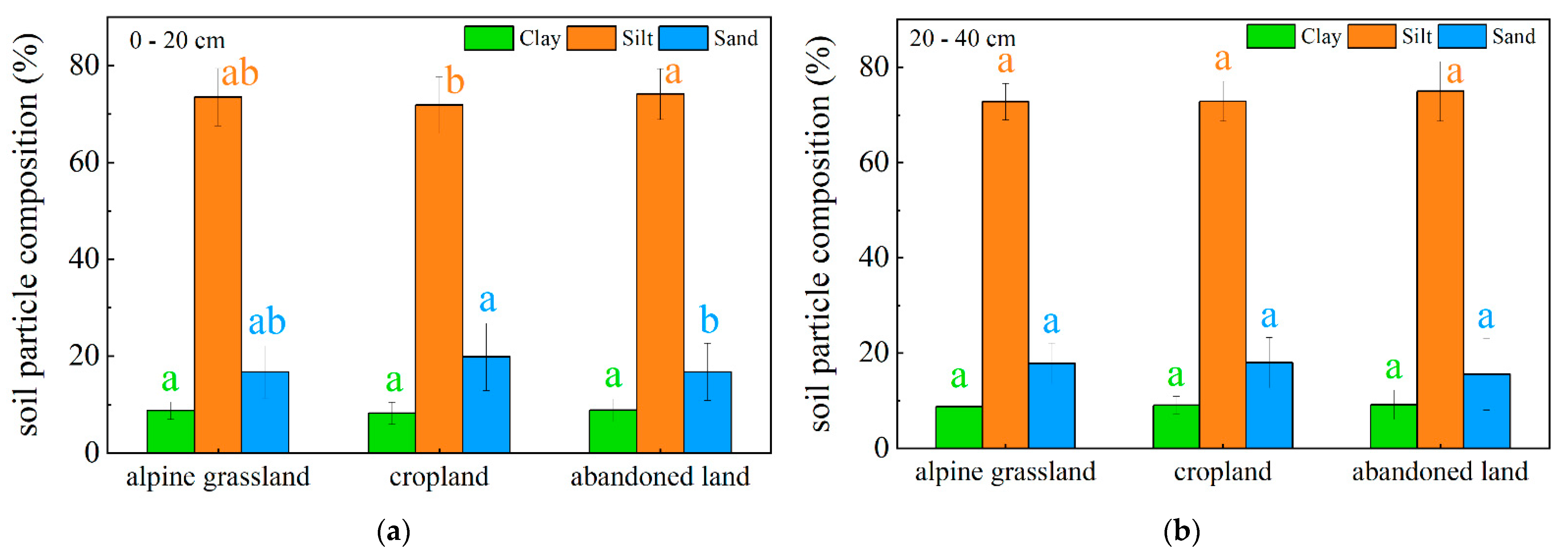

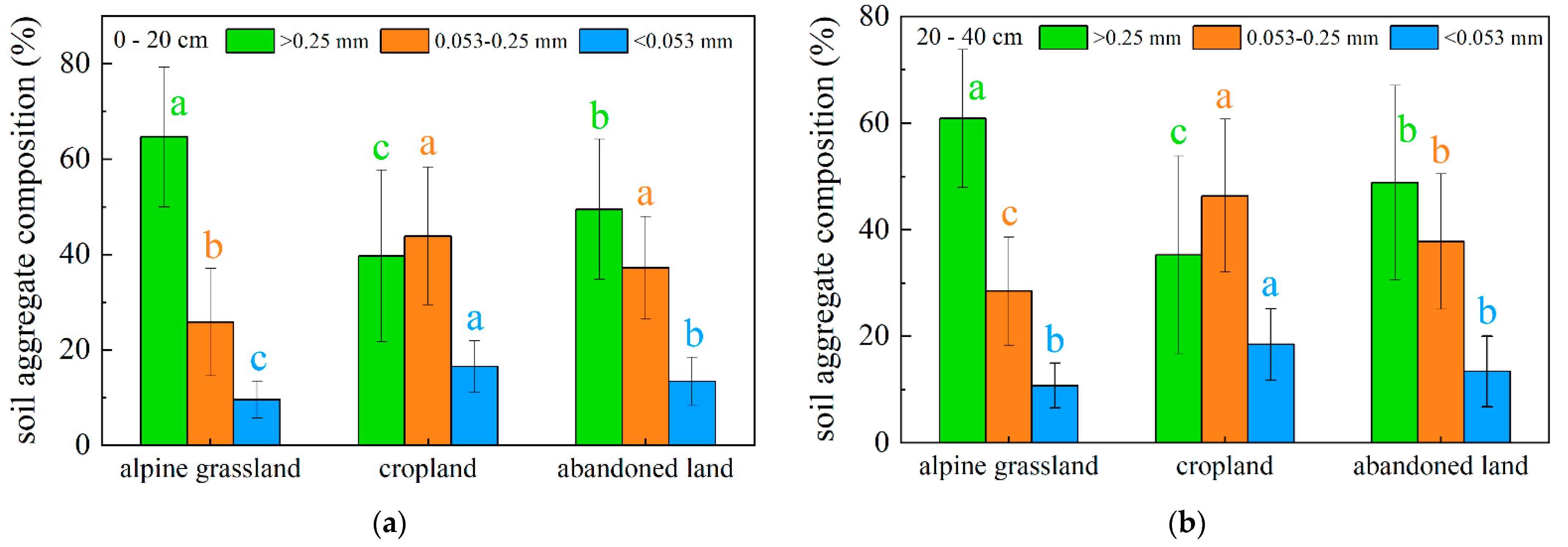


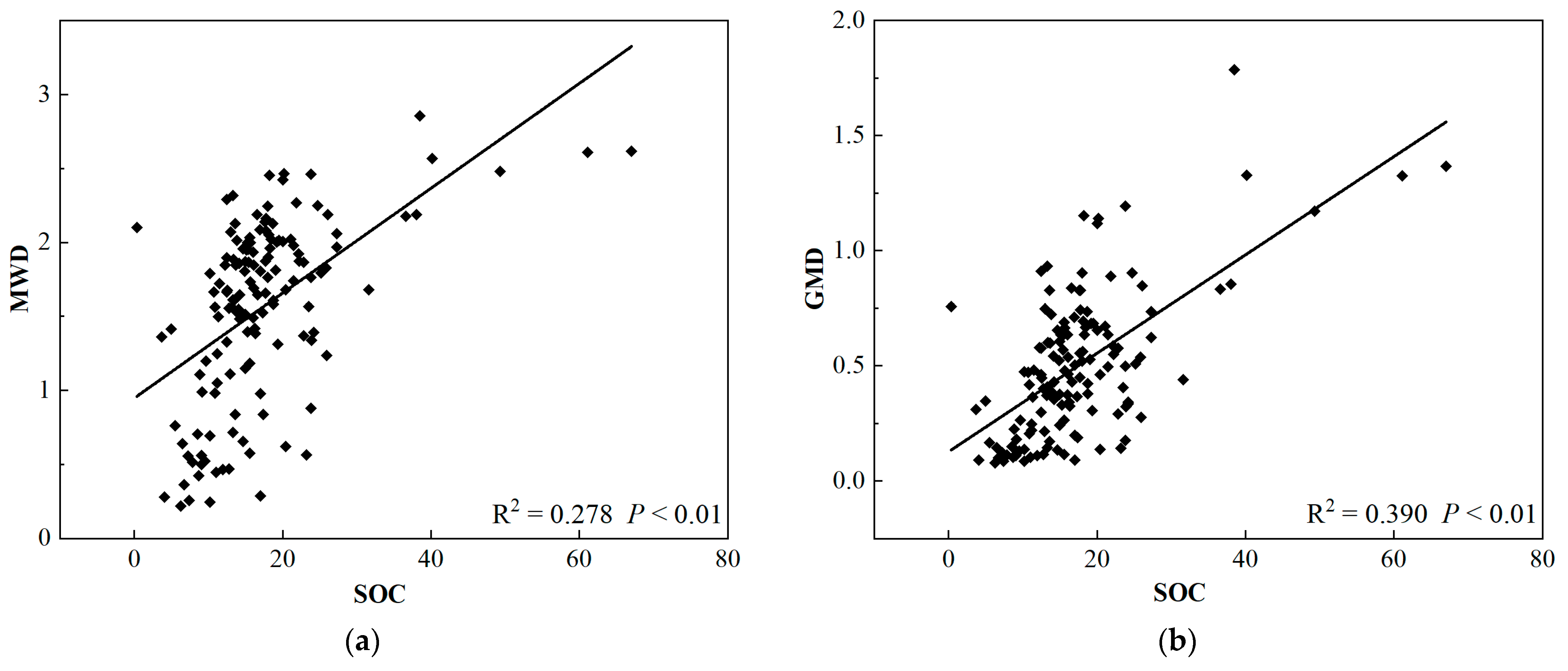
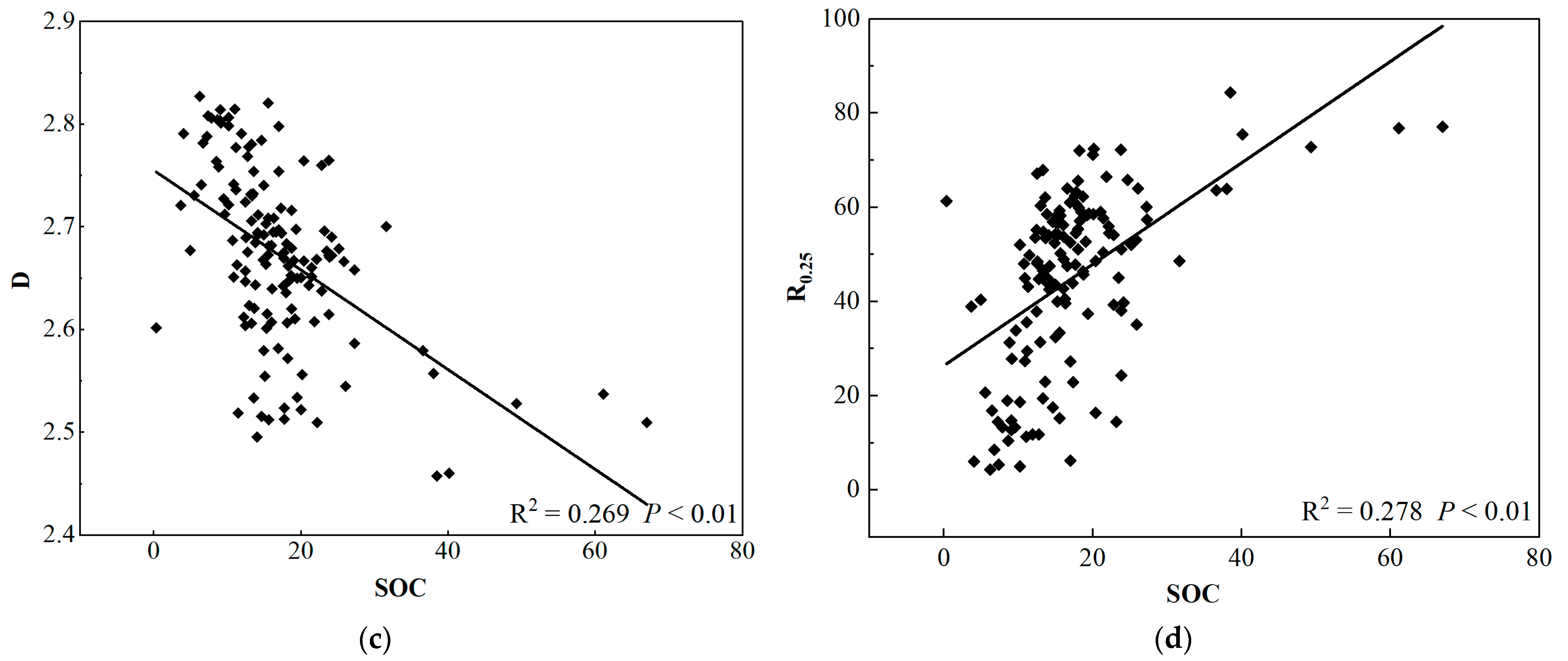
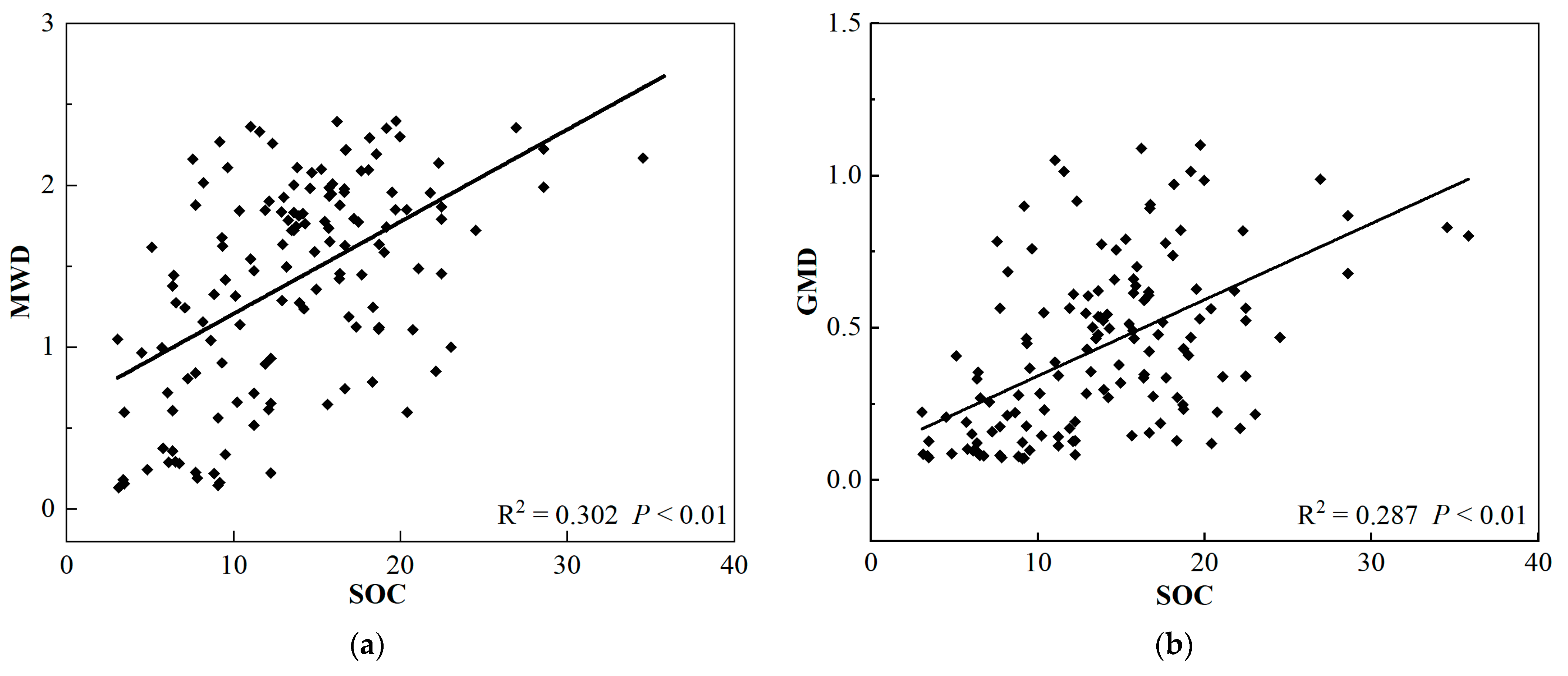
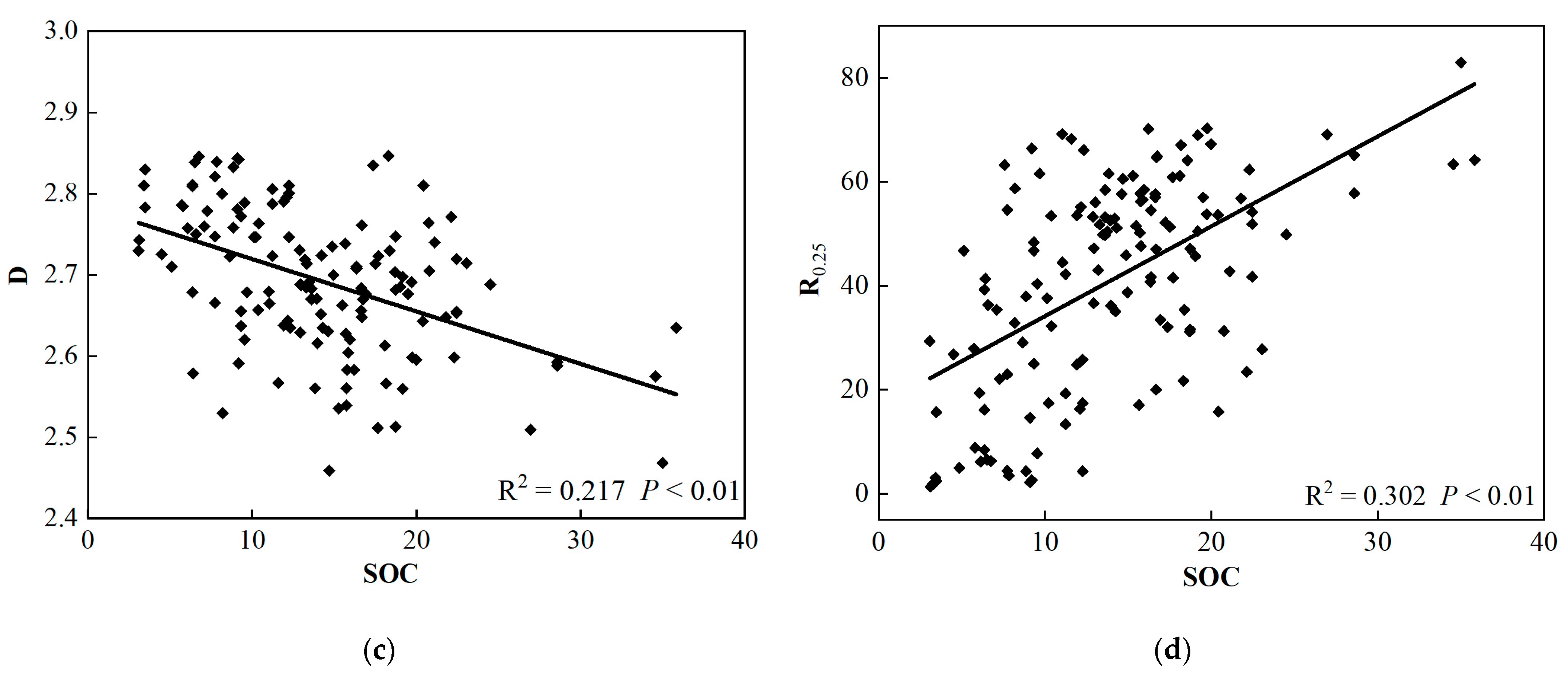


| Land Use Type | Soil Depth (cm) | pH | RDWD (g cm−3) | SOC (g kg−1) | D50 (µm) | Dv (mm) |
|---|---|---|---|---|---|---|
| Alpine grassland | 0–20 | 7.86(0.58) c | 0.00171 (0.00077) a | 28.10(16.45) a | 18.14(5.18) a | 2.72(0.02) a |
| 20–40 | 8.11(0.46) B | 0.00117 (0.00093) A | 18.71(8.30) A | 17.52(4.00) A | 2.71(0.02) A | |
| Cropland | 0–20 | 8.11(0.16) b | 0.00051 (0.00037) b | 16.79(6.84) b | 20.73(6.82) a | 2.71(0.02) a |
| 20–40 | 8.25(0.26) A | 0.00023 (0.00023) B | 13.98(8.20) B | 18.88(4.89) A | 2.71(0.02) A | |
| Abandoned land | 0–20 | 8.28(0.10) a | 0.00082 (0.00069) b | 13.66(4.31) b | 17.73(5.56) a | 2.72(0.02) a |
| 20–40 | 8.34(0.13) A | 0.00013 (0.00006) B | 13.46(4.92) B | 16.99(6.64) A | 2.72(0.03) A |
| Factor | Variable | df | F-Value | p-Value |
|---|---|---|---|---|
| Land use change | SOC | 2 | 13.967 | 0.000 ** |
| Clay | 2 | 0.599 | 0.550 | |
| Silt | 2 | 3.814 | 0.023 * | |
| Sand | 2 | 4.557 | 0.011 * | |
| Soil depth | SOC | 1 | 12.386 | 0.001 ** |
| Clay | 1 | 1.214 | 0.272 | |
| Silt | 1 | 0.255 | 0.614 | |
| Sand | 1 | 0.453 | 0.501 | |
| Land use change × Soil depth | SOC | 2 | 3.870 | 0.022 * |
| Clay | 2 | 0.695 | 0.500 | |
| Silt | 2 | 0.343 | 0.710 | |
| Sand | 2 | 0.684 | 0.506 | |
| Land use change | MWD | 2 | 28.520 | 0.000 ** |
| GMD | 2 | 50.826 | 0.000 ** | |
| D | 2 | 40.962 | 0.000 ** | |
| R0.25 | 2 | 34.932 | 0.000 ** | |
| Soil depth | MWD | 1 | 2.173 | 0.553 |
| GMD | 1 | 4.410 | 0.142 | |
| D | 1 | 2.079 | 0.037 * | |
| R0.25 | 1 | 0.354 | 0.151 | |
| Land use change × Soil depth | MWD | 2 | 0.699 | 0.498 |
| GMD | 2 | 0.312 | 0.732 | |
| D | 2 | 1.588 | 0.206 | |
| R0.25 | 2 | 0.161 | 0.851 |
| Soil Depth (cm) | Dependent Variable | Formula | R2 |
|---|---|---|---|
| 0–20 | MWD | MWD = 1.503 + 0.031 × SOC − 0.031 × D50 | 0.446 ** |
| GMD | GMD = 0.288 + 0.017 × SOC − 0.009 × D50 | 0.529 ** | |
| D | D = 2.781 − 0.005 × SOC | 0.401 ** | |
| R0.25 | R0.25 = 43.288 + 0.932 × SOC − 0.949 × D50 | 0.446 ** | |
| 20–40 | MWD | MWD = 56.234 + 0.024 × SOC − 0.162 × D50 − 17.712 × Dv − 0.058 × Silt | 0.492 ** |
| GMD | GMD = 0.320 + 0.014 × SOC − 0.009 × D50 | 0.459 ** | |
| D | D = −4.442 − 0.002 × SOC − 0.021 × D50 + 2.278 × Dv + 0.008 × Silt | 0.377 ** | |
| R0.25 | R0.25 = 1701.850 + 0.715 × SOC − 4.898 × D50 − 536.971 × Dv − 1.178 × Silt | 0.493 ** | |
| 0–40 | MWD | MWD = −2.508 + 0.030 × SOC − 0.095 × D50 + 0.096 × Sand + 0.047 × Silt | 0.472 ** |
| GMD | GMD = 0.294 + 0.014 × SOC − 0.009 × D50 + 96.033 × RDWD | 0.544 ** | |
| D | D = 2.717 − 0.003 × SOC − 0.003 × D50 − 24.106 × RDWD | 0.375 ** | |
| R0.25 | R0.25 = −78.937 + 0.907 × SOC − 2.897 × D50 + 2.913 × Sand + 1.442 × Silt | 0.473 ** |
Disclaimer/Publisher’s Note: The statements, opinions and data contained in all publications are solely those of the individual author(s) and contributor(s) and not of MDPI and/or the editor(s). MDPI and/or the editor(s) disclaim responsibility for any injury to people or property resulting from any ideas, methods, instructions or products referred to in the content. |
© 2023 by the authors. Licensee MDPI, Basel, Switzerland. This article is an open access article distributed under the terms and conditions of the Creative Commons Attribution (CC BY) license (https://creativecommons.org/licenses/by/4.0/).
Share and Cite
Li, Y.; Ma, Z.; Liu, Y.; Cui, Z.; Mo, Q.; Zhang, C.; Sheng, H.; Wang, W.; Zhang, Y. Variation in Soil Aggregate Stability Due to Land Use Changes from Alpine Grassland in a High-Altitude Watershed. Land 2023, 12, 393. https://doi.org/10.3390/land12020393
Li Y, Ma Z, Liu Y, Cui Z, Mo Q, Zhang C, Sheng H, Wang W, Zhang Y. Variation in Soil Aggregate Stability Due to Land Use Changes from Alpine Grassland in a High-Altitude Watershed. Land. 2023; 12(2):393. https://doi.org/10.3390/land12020393
Chicago/Turabian StyleLi, Ying, Zhanming Ma, Yutao Liu, Zilong Cui, Qiuyu Mo, Can Zhang, Haiyan Sheng, Wen Wang, and Yongkun Zhang. 2023. "Variation in Soil Aggregate Stability Due to Land Use Changes from Alpine Grassland in a High-Altitude Watershed" Land 12, no. 2: 393. https://doi.org/10.3390/land12020393






